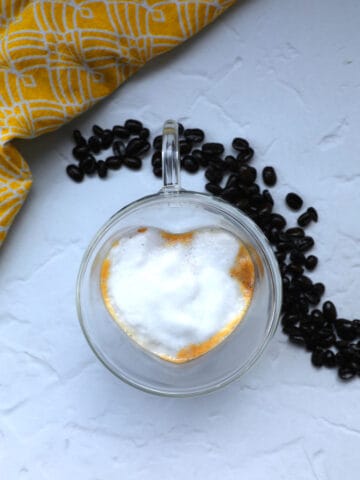These two espresso-based drinks both feature rich coffee flavor, but they have several distinctions which make them their own. Find out the key differences between cortado vs cappuccino. And see how to make them at home.

While the cappuccino may enjoy more name recognition than the cortado, each is a delicious coffee drink made with espresso and milk. And it’s the ratio of those ingredients that makes them unique.
Jump to:
- What is a cortado?
- What does a cortado taste like?
- How do you make a cortado?
- What are some cortado variations?
- What is a cappuccino?
- What does a cappuccino taste like?
- How do you make a cappuccino?
- Which is stronger, cortado or cappuccino?
- What’s the difference between cappuccino vs cortado?
- FAQ
- Get more answers to your coffee questions
What is a cortado?
Originally from Spain, a cortado consists of two shots of espresso mixed with an equal amount of steamed milk. Then it’s usually served in a small 4.5 oz glass.
The Spanish word “cortado” translates to “cut” or “chopped” in English. It refers to the milk used in the drink which is intended to cut, or cut through, the strong flavor of the espresso.
Because of the specific ratios of the ingredients required to get the right flavor and texture, you typically won’t see a cortado served in a large cup at specialty coffee shops. That’s one way it’s unique to cappuccinos or lattes, which can use larger amounts of espresso and milk.

What does a cortado taste like?
The equal parts espresso and milk in a cortado give the drink a pleasant but not overpowering coffee flavor. And the steamed milk lends it an easy-drinking, velvety texture. The idea of mixing the ingredients in the same amounts is so the milk can balance out the stronger espresso and moderate some of its acidity.
How do you make a cortado?
It’s easy to make a cortado at home.
Step 1 – Start by adding two shots of espresso to a 4.5 oz glass.
Step 2 – Then steam some milk, either with your espresso machine’s steam wand or on the stovetop.
Step 3 – Add 2 oz of steamed milk to the espresso in the cup. Enjoy!
💡Tip: If you don’t have an espresso maker, you can use a regular coffee maker that has a “rich” setting to make a strong, small cup of coffee. If you have a Keurig or Nespresso machine, set it to make espresso and just use equal parts espresso and milk.
What are some cortado variations?
It’s common to find cortados made with sweetened, condensed milk in Spain. This is called a cortado condensada. Similarly, a Cuban version of a cortado — called a Cortadito — can be sweetened with condensed milk or some sugar.
A cortado may also be referred to as a Gibraltar due to the ridged, small glass of the same name that the drink is often served in.
While a cortado is traditionally made with cow’s milk, you can also substitute non-dairy varieties that still steam well, like almond or oat milk.
👉🏼 Related: Cortado vs Flat White
What is a cappuccino?
A cappuccino is equal parts espresso, steamed milk, and milk foam. Cappuccinos can be made with a single shot of espresso or a double shot. They’re traditionally served in cups ranging from 5 to 8 oz and they can be topped with a dusting of cinnamon or cocoa powder.
A cappuccino has similarities to a latte in that the ingredients are the same. But lattes have a much thinner layer of foam, whereas cappuccinos are topped with thick milk foam, giving them a light, airy texture.

What does a cappuccino taste like?
With its greater espresso-to-milk ratio, a traditional cappuccino has a pronounced yet mild coffee flavor. But it’s the drink’s signature texture that really sets it apart. The large top layer of milk foam helps make a cappuccino feel softer and lighter than other similar drinks like lattes or flat whites.
How do you make a cappuccino?
You don’t need to go to your local coffee shop to get a great-tasting cappuccino. They’re easy to make at home in just a few steps.
It’s best if you have an espresso maker, but a coffee machine that makes a rich, strong cup of coffee will work too. Simply using regular drip coffee will not create the right taste or texture for a really good cappuccino.
Step 1 – Make a 1 oz espresso shot (or rich coffee).
Step 2 – Either steam your milk with your espresso machine’s steam wand or heat it on the stovetop. If you use the stovetop, heat the milk until it’s hot but not bubbling.
Step 3 – Use a milk frother or whisk to create the milk foam.
Step 4 – Gently pour the hot milk and foam over the espresso in a 5-8 oz cup. That’s it!
💡 Tip: You can also use a double shot of espresso if you prefer more of a coffee kick.
Which is stronger, cortado or cappuccino?
The caffeine content of a cortado and a cappuccino will be the same if each uses the same number of espresso shots. One shot contains about 65 mg of caffeine. A double shot of espresso will have about 130 mg of caffeine.
When it comes to palate, you may notice more coffee intensity in a cortado, since it contains the same ratio of espresso to milk. A cappuccino on the other hand has one-third steamed milk, one-third milk foam, and one-third espresso. The greater amount of milk and milk foam lends it a milder coffee flavor.
What’s the difference between cappuccino vs cortado?
The main difference between these two coffee drinks comes down to the ratio of espresso to milk, along with each drink’s texture.


A cortado uses an equal amount of espresso as it does milk — about 2 oz of each — which creates a rich, balanced coffee taste, but with a stronger flavor than cappuccino. It has a smooth texture, but it does not contain a milk foam layer on top, and it’s usually served in a small 4.5 oz glass.
A cappuccino uses one-third espresso to two-thirds steamed and foamed milk. This results in a more mellow coffee taste with a light, airy texture, due to the foamy top later. It’s also a larger drink than a cortado and is usually served in 5-8 oz sizes.
The bottom line: each is made with espresso and milk, but the varying amounts of the ingredients and the resulting difference in texture produce two very different coffee experiences.
So if you’d never heard of a cortado before, now you know! Give one a try the next time you’re in the mood for a delicious coffee pick-me-up!
FAQ
While both are made with espresso and steamed milk, a cortado has less milk than a flat white. And the milk in a flat white is both steamed and lightly frothed. That creates a thin layer of microfoam that blends with the espresso to create a rich, creamy texture.
A flat white also sometimes uses a ristretto shot of espresso. That’s smaller but stronger than a regular shot, so it can result in a more espresso-forward drink than a cortado.
The biggest difference is the amount of milk used. A cappuccino contains equal parts espresso, steamed milk, and milk foam. The frothed milk foam gives it a lighter, airier texture. A latte uses one-third espresso with two-thirds steamed milk (or more depending on personal preference). It’s milkier and doesn’t have the same light, foaminess as a cappuccino. Lattes can also be made either hot or iced.
Get more answers to your coffee questions
Learn more about the wonderful world of coffee and what sets different coffee drinks apart. Check out the posts below.






Leave a Reply